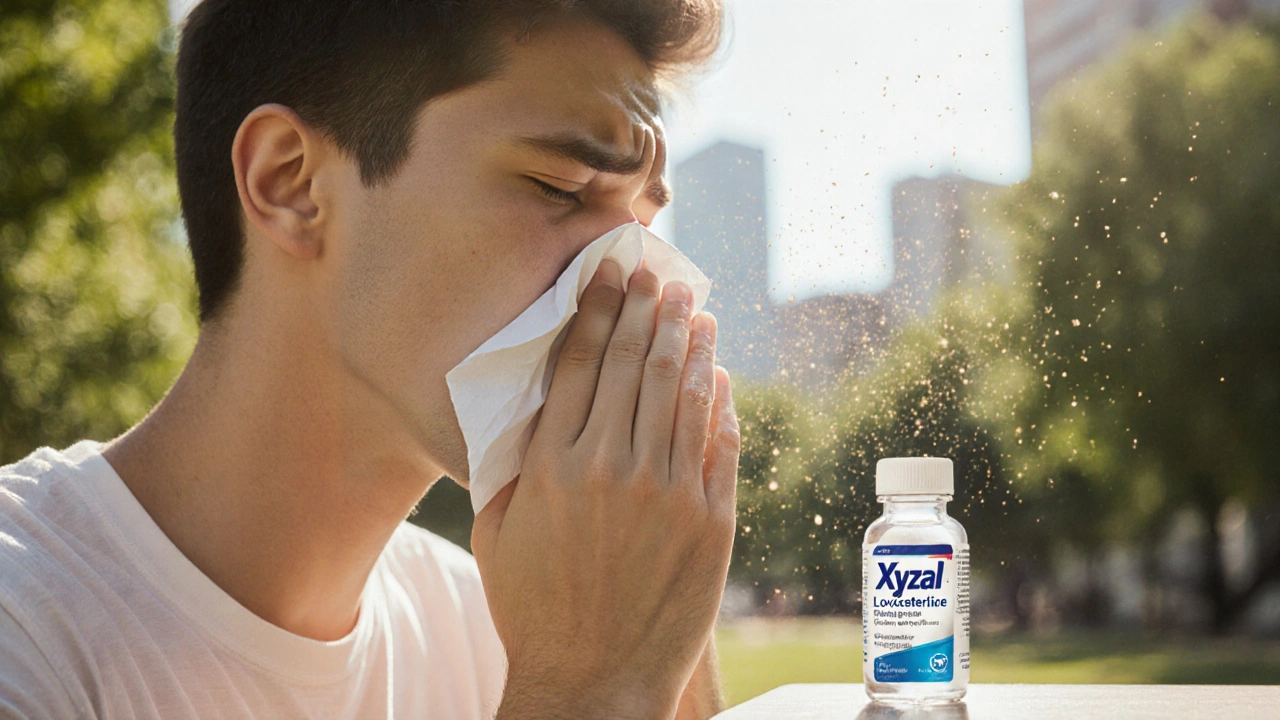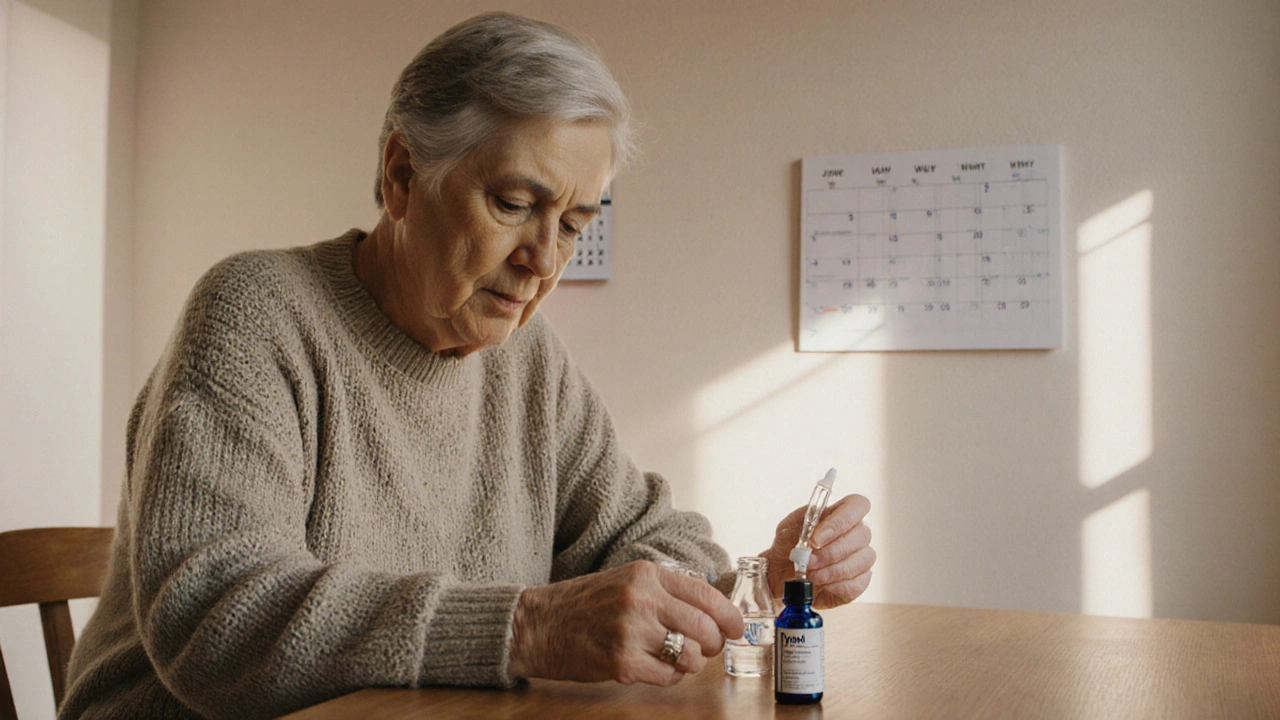 Sep, 27 2025
Sep, 27 2025
Antihistamine Comparison Tool
| Medicine | Active Ingredient | Onset (hrs) | Duration (hrs) | Sedation Risk | Typical Adult Dose |
|---|---|---|---|---|---|
| Xyzal | Levocetirizine 5 mg | 1 | 24 | Low (≈5%) | 5 mg once daily |
| Cetirizine | Cetirizine 10 mg | 1 | 24 | Moderate (≈10%) | 10 mg once daily |
| Loratadine | Loratadine 10 mg | 1-2 | 24 | Low (≈5%) | 10 mg once daily |
| Fexofenadine | Fexofenadine 180 mg | 1-2 | 24 | Very low (≈2%) | 180 mg once daily |
| Desloratadine | Desloratadine 5 mg | 1 | 24 | Low (≈5%) | 5 mg once daily |
| Diphenhydramine | Diphenhydramine 25 mg | 0.5 | 4-6 | High (≈70%) | 25-50 mg every 4-6 h |
Xyzal (Levocetirizine) is a second‑generation antihistamine that blocks the H1 receptors responsible for allergy symptoms. It was approved in the UK in 2007 and quickly became a go‑to for seasonal hay fever, chronic urticaria, and allergic rhinitis thanks to its rapid onset (about 1hour) and low sedation risk.
Quick Snapshot - What You Need to Know
- Onset: ~1hour
- Duration: 24hours per dose
- Sedation: Minimal (≈5% of users report drowsiness)
- Typical adult dose: 5mg once daily
- Best for: moderate‑to‑severe allergic rhinitis and chronic hives
How Xyzal Works Compared to First‑Generation Antihistamines
First‑generation drugs like diphenhydramine cross the blood‑brain barrier more readily, which is why they cause pronounced drowsiness. Diphenhydramine (Benadryl) is the classic example; it blocks H1 receptors but also binds to muscarinic and serotonin receptors, leading to anticholinergic side‑effects such as dry mouth and blurred vision. By contrast, Xyzal is highly selective for peripheral H1 receptors, keeping central nervous system effects low while still providing effective symptom relief.
Head‑to‑Head: Xyzal vs Popular Second‑Generation Antihistamines
When you walk into a pharmacy, you’ll usually see a handful of other non‑sedating antihistamines. Below is a concise look at how they differ.
| Medicine | Active Ingredient | Onset (hrs) | Duration (hrs) | Sedation Risk | Typical Adult Dose |
|---|---|---|---|---|---|
| Xyzal | Levocetirizine 5mg | 1 | 24 | Low (≈5%) | 5mg once daily |
| Cetirizine | Cetirizine 10mg | 1 | 24 | Moderate (≈10%) | 10mg once daily |
| Loratadine | Loratadine 10mg | 1‑2 | 24 | Low (≈5%) | 10mg once daily |
| Fexofenadine | Fexofenadine 180mg | 1‑2 | 24 | Very low (≈2%) | 180mg once daily |
| Desloratadine | Desloratadine 5mg | 1 | 24 | Low (≈5%) | 5mg once daily |
| Diphenhydramine | Diphenhydramine 25mg | 0.5 | 4‑6 | High (≈70%) | 25‑50mg every 4‑6h |
Beyond Antihistamines: When You Might Choose a Different Class
If antihistamines alone aren’t cutting it, doctors often add other drug classes. Fluticasone (Fluticasone propionate) nasal spray is a corticosteroid that reduces nasal inflammation at the source, providing relief for persistent allergic rhinitis that doesn’t respond fully to oral antihistamines.
Another option is Montelukast, a leukotriene‑receptor antagonist. It blocks chemical mediators released by mast cells, making it useful for patients who suffer from both asthma and allergic rhinitis.

Pros and Cons - When Xyzal Is the Right Pick
- Pros
- Fast 1‑hour onset, ideal for sudden flare‑ups.
- 24‑hour coverage means once‑daily dosing.
- Very low sedation makes it safe for daytime use and driving.
- Proven efficacy for chronic urticaria where other antihistamines may fall short.
- Cons
- Higher price point than generic cetirizine or loratadine in the UK.
- Rare cases of headache or dry mouth.
- Not recommended for patients with severe renal impairment without dose adjustment.
Choosing an Alternative - Decision Guide
Think of the choice as a simple flow:
- Sedation tolerance? If you need absolutely no drowsiness, Fexofenadine has the lowest risk, followed closely by Loratadine and Desloratadine.
- Budget constraints? Generic Cetirizine is usually the cheapest option with similar efficacy.
- Rapid relief needed? Diphenhydramine works fastest but at the cost of heavy sedation - best for occasional night‑time use.
- Multi‑symptom control (asthma + rhinitis)? Combine an antihistamine with Montelukast or add a nasal steroid like Fluticasone.
Practical Tips for Getting the Most Out of Xyzal or Any Antihistamine
- Take the tablet with a full glass of water; food doesn’t affect absorption much, but some people prefer taking it after a meal to avoid a mild stomach upset.
- Stick to the same time each day. Consistency helps maintain plasma levels and prevents breakthrough symptoms.
- If you notice lingering daytime sleepiness, try shifting the dose to bedtime - this works for most second‑generation antihistamines.
- Never double‑dose to chase quicker relief; the drug’s half‑life (≈20hours) means higher doses only increase side‑effects.
- Keep an eye on interactions: Xyzal can increase plasma levels of theophylline and some antifungals. Always alert your pharmacist.
When to See a Healthcare Professional
Even the best antihistamine can’t replace a proper medical assessment. Schedule a GP visit if:
- Symptoms persist more than two weeks despite daily dosing.
- You develop swelling of lips, tongue, or throat - signs of anaphylaxis.
- You need to combine multiple allergy medications; a doctor can guide safe combinations.
- You’re pregnant, nursing, or have chronic kidney disease - dosage may need adjustment.
Related Concepts and Next Steps
Understanding Xyzal’s place in allergy management opens doors to deeper topics. You might explore:
- Allergen immunotherapy - long‑term desensitisation through allergy shots or sublingual tablets.
- Environmental control strategies - air filtration, dust‑mite covers, and pollen forecasts.
- Pharmacogenomics - why some patients respond better to levocetirizine versus cetirizine.
Each of these areas builds on the foundation you’ve just read about, helping you become a more informed patient or caregiver.

Frequently Asked Questions
How quickly does Xyzal start working?
Most people feel relief within 30‑60 minutes, with peak effect around two hours. It’s fast enough for sudden hay‑fever spikes but still lasts all day.
Is Xyzal safe for children?
Yes, it’s licensed for children from 6years old at a 2.5mg dose (half an adult tablet). For younger kids, doctors usually prefer cetirizine or loratadine.
Can I take Xyzal with alcohol?
Mixing alcohol with any antihistamine can increase drowsiness, even with low‑sedating drugs. A small glass is unlikely to cause trouble, but stay cautious and avoid heavy drinking.
What’s the biggest difference between Xyzal and cetirizine?
Levocetirizine is the active (R‑) enantiomer of cetirizine, meaning it delivers the same effect at half the dose and typically produces slightly fewer side‑effects. Clinical trials show comparable efficacy.
Why might a doctor add a nasal steroid to my antihistamine regimen?
Antihistamines block the histamine pathway, but nasal inflammation is also driven by other mediators like prostaglandins. A steroid spray such as Fluticasone targets that inflammation directly, offering better overall control for stubborn rhinitis.
Amanda Hamlet
September 27, 2025 AT 15:45Look, if you’re gonna pick an antihistamine you should know that Xyzal’s sedation rate is only about five per cent, which is way lower than Benadryl’s crazy seventy per cent – that’s basic pharm knowledge you’d expect anyone to have. Also, the drug hits within an hour, so you’re not waiting all day for relief.
Nolan Jones
September 28, 2025 AT 05:38The chart you posted is handy – it shows that most second‑gen antihistamines have a 24‑hour window, so you can just take one pill in the morning and forget about it. If you’re on a budget, generic cetirizine usually costs less and works almost the same as Xyzal.
Emily Rossiter
September 28, 2025 AT 19:32For anyone dealing with chronic hives, staying consistent with the same dose each day can make a big difference. Setting a reminder on your phone helps keep plasma levels steady and reduces those annoying flare‑ups.
Renee van Baar
September 29, 2025 AT 09:25Exactly, Nolan. The cost factor matters a lot for long‑term use. While the generic is cheaper, some patients notice a slight dip in efficacy compared to the branded version, especially when they have severe allergic rhinitis. That’s why I usually suggest trying the generic first for a month; if symptoms persist, a switch to the branded Xyzal can provide that extra edge without breaking the bank. Also, consider the timing – taking it with food can minimise any mild stomach upset you might feel.
Mithun Paul
September 29, 2025 AT 23:18It is incumbent upon the author to acknowledge that the comparative matrix omits pharmacokinetic parameters such as Cmax and AUC, which are pivotal for a comprehensive assessment of antihistaminic efficacy. The exclusion of these metrics compromises the scientific robustness of the presented analysis.
Sandy Martin
September 30, 2025 AT 13:12I understand how frustrating it can be when a medication causes a dry mouth. Staying hydrated and chewing sugar‑free gum often alleviates that sensation without interfering with the drug’s absorption.
Steve Smilie
October 1, 2025 AT 03:05One must eschew the pedestrian habit of merely juxtaposing onset times; instead, contemplate the symphonic interplay between histamine blockade and downstream cytokine modulation, which endows Xyzal with its mellifluous therapeutic profile.
David Lance Saxon Jr.
October 1, 2025 AT 16:58When we examine the ontological underpinnings of antihistaminic selection, Xyzal emerges not merely as a pharmacological agent but as an embodiment of the principle of selective H1 antagonism.
Its R‑enantiomeric purity confers a pharmacodynamic precision that eclipses the racemic mixture of cetirizine.
This molecular asymmetry translates clinically into a reduced off‑target interaction profile, thereby mitigating sedation.
The temporal kinetics-onset within one hour and a half‑life approaching twenty hours-render it a chronologically harmonious choice for diurnal symptom management.
Moreover, the low incidence of drowsiness aligns with modern occupational demands where cognitive alertness is non‑negotiable.
While cost considerations are salient, the value proposition of Xyzal lies in its consistency across heterogeneous patient phenotypes, particularly those with refractory chronic urticaria.
From a health economics perspective, fewer missed workdays offset the premium pricing relative to generic counterparts.
The comparative table, however, fails to incorporate the nuance of hepatic CYP3A4 inhibition, a factor that can potentiate concomitant agents such as theophylline.
Clinicians must therefore appraise drug‑drug interaction matrices before co‑prescribing.
In practice, patient education on the importance of adherence cannot be over‑stated, as erratic dosing erodes the steady‑state concentration essential for symptom suppression.
Environmental control measures-air filtration, dust‑mite encasements-synergize with pharmacotherapy, creating a multidimensional defense.
The addition of intranasal corticosteroids, for instance fluticasone, addresses the inflammatory cascade that antihistamines alone may not quell.
Likewise, leukotriene receptor antagonists like montelukast provide adjunctive relief for those with comorbid asthma.
In sum, Xyzal offers a balanced amalgam of efficacy, safety, and convenience, situating it as a first‑line contender in the antihistamine armamentarium.
Future comparative studies should expand endpoints to include quality‑of‑life metrics, thereby enriching the evidence base that informs clinical decision‑making.
Moore Lauren
October 2, 2025 AT 06:52Grab your Xyzal early and stay on top of your allergies
Jonathan Seanston
October 2, 2025 AT 20:45Hey, just a heads up – if you notice any lingering drowsiness, shifting the dose to bedtime can totally solve that issue without compromising relief
Lawrence D. Law
October 3, 2025 AT 10:38It is, without doubt, advisable, to consider both the pharmacodynamic and pharmacokinetic profiles, of each antihistamine; however, one must also weigh the economic implications, and patient-specific factors, before finalizing a therapeutic regimen.
Mary K
October 4, 2025 AT 00:32Life is a pollen‑filled battlefield; you need the right shield, and Xyzal is that sleek, low‑sedation sword that cuts through sneezes with elegant fury, so charge forward and defeat those allergens!
Odin Zifer
October 4, 2025 AT 14:25they dont tell you that big pharma pushes these meds to keep you dependent they want you buying more
Marisa Leighton
October 5, 2025 AT 04:18Listen up! If you’re battling relentless hay‑fever, Xyzal might just be the heroic sidekick you’ve been searching for. Its rapid onset means you won’t be stuck in a sneeze‑marathon, and the low sedation keeps you sharp for that crucial meeting or workout. Don’t let the price intimidate you – consider a short trial period and see if the relief justifies the cost. Remember, the right antihistamine can transform a miserable day into a victorious one.
Brennan Keeler
October 5, 2025 AT 18:12Look, the efficacy data clearly shows Xyzal outperforms generic cetirizine in severe cases – the stats dont lie, its a win‑win for patient outcomes
Michael Dion
October 6, 2025 AT 08:05Meh.
Trina Smith
October 6, 2025 AT 21:58While the science of antihistamines is solid, we must also reflect on how our environment shapes our reactions 🌿; integrating mindfulness with medication can enhance overall wellbeing 🧘♀️.